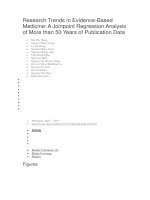Lecture Communication research: Asking questions, finding answers (4e) Chapter 12: Quantitative analysis of text
Bạn đang xem bản rút gọn của tài liệu. Xem và tải ngay bản đầy đủ của tài liệu tại đây (479.31 KB, 18 trang )
Chapter 12
QUANTITATIVE ANALYSIS OF TEXT
Copyright © 2015 McGraw-Hill
Education. All rights reserved. No
reproduction or distribution without
the prior written consent of
McGraw-Hill Education.
Study of texts or messages is central to the
communication discipline
Two data collection and analytical methods
Content
analysis
Interaction analysis
Copyright © 2015 McGraw-Hill
Education. All rights reserved. No
reproduction or distribution without
the prior written consent of
McGraw-Hill Education.
CONTENT ANALYSIS
A data collection and
analytical technique
Can make inferences by
identifying specific
characteristics of
messages
Manifest content
Latent content
Objective
Systematic
Carried out according to
rules and procedures
Identifying content to be
coded
Coding and interpreting
content
Generality
Findings should have
theoretical relevance
Copyright © 2015 McGraw-Hill
Education. All rights reserved. No
reproduction or distribution without
the prior written consent of
McGraw-Hill Education.
BASIC PRINCIPLES OF CONTENT ANALYSIS
Messages can be classified into a set of categories
Elements classified together have similar meanings
Categories produce frequency counts to allow for
comparisons
Evaluate the relevance of frequencies to the theoretical
propositions supporting the study
Copyright © 2015 McGraw-Hill
Education. All rights reserved. No
reproduction or distribution without
the prior written consent of
McGraw-Hill Education.
WHAT CAN BE ANALYZED?
Sources, senders, or
receivers of messages
Functions or types of
messages
Message channels
Content of messages
Message effects
Nonverbals cues or behaviors
Sounds
Visual images
Webages
Text messages, tweets
Topics
Copyright © 2015 McGraw-Hill
Education. All rights reserved. No
reproduction or distribution without
the prior written consent of
McGraw-Hill Education.
CONTENT ANALYSIS PROCESS
1.
Develop hypothesis or research question that calls for
content analysis
2.
Select messages to be analyzed
3.
Select categories and units for coding
4.
Develop procedures for resolving coding differences
5.
If all messages cannot be coded, select sample
6.
Code messages into categories
7.
Interpret the results of the coding
Copyright © 2015 McGraw-Hill
Education. All rights reserved. No
reproduction or distribution without
the prior written consent of
McGraw-Hill Education.
SELECTING WHAT TO CODE
Are the messages available or must they be created?
Narrow the data set for the elements of interest
May still need to sample elements
Messages may have structural characteristics that
need to be considering in sampling
Copyright © 2015 McGraw-Hill
Education. All rights reserved. No
reproduction or distribution without
the prior written consent of
McGraw-Hill Education.
DEVELOPING CONTENT CATEGORIES
Theoretical or emergent
What was said
How message was said
Categories must be
Exhaustive
Equivalent
Mutually exclusive
Be careful of using “other” as a catchall category
Copyright © 2015 McGraw-Hill
Education. All rights reserved. No
reproduction or distribution without
the prior written consent of
McGraw-Hill Education.
UNITS OF ANALYSIS
Complete thoughts or
sentences
Themes
Paragraphs
Characters or speakers
Communicative acts,
behaviors, or processes
Television programs or
scenes
Advertisements
Discrete element that is
coded and counted
Rules for identifying the
unit should be explicit
Typical units of
analysis in
communication
Copyright © 2015 McGraw-Hill
Education. All rights reserved. No
reproduction or distribution without
the prior written consent of
McGraw-Hill Education.
TRAINING CODERS
All coders must be trained
Increases coding agreement
Commit coding system and rules to paper
Practice on similar texts or messages
Once sufficient degree of reliability is established,
coders then work independently
Copyright © 2015 McGraw-Hill
Education. All rights reserved. No
reproduction or distribution without
the prior written consent of
McGraw-Hill Education.
CODING RELIABILITY AND VALIDITY
Intercoder or interrater reliability
Unitizing
Do
we identify the same thing to code?
Coding
Do
reliability
reliability
we code it in the same way?
Validity – appropriateness and adequacy of
coding scheme for this set of messages
Copyright © 2015 McGraw-Hill
Education. All rights reserved. No
reproduction or distribution without
the prior written consent of
McGraw-Hill Education.
INTERPRETING CODING RESULTS
Analysis must be relevant to hypothesis or
research question
Frequencies
Differences
Trends
Patterns
Standards
Copyright © 2015 McGraw-Hill
Education. All rights reserved. No
reproduction or distribution without
the prior written consent of
McGraw-Hill Education.
STRENGTHS
LIMITATIONS
Data close to the
communicator
If message cannot be
captured, it cannot be coded
Unobtrusive
Coding scheme may not
reveal nuances of messages
Applicable to a variety of text
or message structures
Selection process may not be
representative
STRENGTHS AND LIMITATIONS
OF CONTENT ANALYSIS
INTERACTION ANALYSIS
Researcher codes content of ongoing communication between
two or more individuals
Identifies verbal or nonverbal features or functions from the
stream of conversation
Allows complex analyses
Intent and function of messages
Effect of messages
Examines messages relative to one another over time
Copyright © 2015 McGraw-Hill
Education. All rights reserved. No
reproduction or distribution without
the prior written consent of
McGraw-Hill Education.
PREPARING AND CODING INTERACTION
Interaction is recorded and then transcribed
Coders trained
Interaction must be unitized
Interaction coded according to coding scheme
Unitizing reliability calculated
Coding reliability calculated
All coding differences resolved
Copyright © 2015 McGraw-Hill
Education. All rights reserved. No
reproduction or distribution without
the prior written consent of
McGraw-Hill Education.
ANALYZING AND INTERPRETING CODED DATA
Return to the research question or hypothesis
Compare to theoretical position
Frequency analysis is common
Look for patterns that simple frequency
analyses cannot illuminate
Copyright © 2015 McGraw-Hill
Education. All rights reserved. No
reproduction or distribution without
the prior written consent of
McGraw-Hill Education.
EXAMPLE OF INTERACTION ANALYSIS
Copyright © 2015 McGraw-Hill
Education. All rights reserved. No
reproduction or distribution without
the prior written consent of
McGraw-Hill Education.
STRENGTHS
LIMITATIONS
Elements before and after
a coded element are
considered
Limited by validity and
representativeness of coding
scheme
Places emphasis on
relative position
Several coding schemes
have been developed and
validated over time
Ongoing streams of
conversation are not neat
and tidy – can be difficult to
code
Time consuming
STRENGTHS AND LIMITATIONS
OF INTERACTION ANALYSIS









